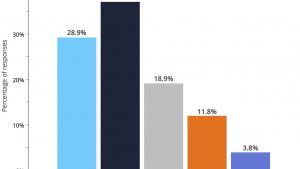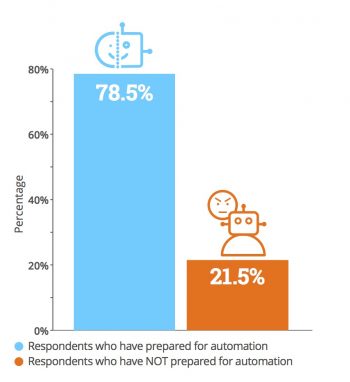A LivePerson survey found that many Americans are worried about robots taking jobs, but less about automation affecting their own work. What should government and business do in response?

Back in 2013, an Oxford Martin School study stated that 47% of U.S. jobs are “at risk” from automation. This contributed to widespread worries about robots taking jobs, even as companies across industries continue to adopt the technology. But are they directed at the right things?
LivePerson Inc., which provides live chat software and studies online marketing, has released its own study about automation. In January, the New York-based company surveyed more than 2,000 people about their experiences and opinions about AI and employment.
“We have a detailed way of looking at the nature of work that’s causational,” said Rurik Bradbury, head of global communications and research at LivePerson. “There’s a big time lag between public perception and facts on the ground.”
[note style=”success” show_icon=”false”]Business Takeaways:
- A LivePerson survey of 2,000 people confirmed that many have fears of robots taking jobs (see image above).
- However, almost half of respondents were more worried about other people’s jobs than their own.
- Governments and business need to take responsibility for retraining workers and alleviating fears of automation.
Perceptions of automation
Public concerns about robots taking jobs are a challenge for the robotics industry, particularly in the U.S. and U.K.
“The results from the two countries were broadly similar, as we thought they would be,” Bradbury said. “There is an overlap of themes, debate, and media reading with no language barrier.”

LivePerson found that about half of respondents are somewhat concerned about automation. (Click here to enlarge.)
LivePerson’s expertise in software bots guided its research into attitudes toward automation.
“Because we work with call centers, about half our work is fairly predictable and simple to automate,” he added. “Bots can handle password resets and account updates, and there’s not a big regulatory hurdle.”
“Once you’re talking about messaging software on smartphones, it makes sense to talk about automation through bots as well,” Bradbury said. “From speaking to people in Japan and Germany, there’s less concern in those countries because they have more social protections and more worker shortages due to aging populations.”
Role of the news media
Since that first Oxford Martin study, numerous pundits have warned that robots and AI are coming for both blue-collar and white-collar jobs. Last year, Oxford Martin published an updated report about robots taking jobs, reiterating that 47% of jobs are at “high risk” of being automated.
“The headlines that grab me the most extrapolate incorrectly from the Oxford study,” Bradbury noted. “High risk is not the same as a prediction of job losses.”
“Headlines citing The Terminator are easy to write, but some journalists are trying to be more responsible,” Bradbury said. “It won’t be an apocalypse, but it won’t be a smooth, slow transition either.”
“I don’t know if you can say the fear level is higher, but there are inflection points,” Bradbury told Robotics Business Review. “It’s like the beginnings of the Industrial Revolution. The displacement could lead to a culture clash, which is a problem.”
Speed of transition is key
“It’s not that new jobs won’t be created, but that there might be nothing in the interim,” he added. “The speed of this change is key. Headlines imply that jobs are going to disappear overnight.”
“If you think about the cycle of automation that has been happening for the past 200 years, you can see this kind of constant turnover of jobs,” Bradbury said. “There’s not a lot of manual bookbinding, nor do we spend our time at home sewing clothes. … There’s continual turnover.”

Bots can relieve call centers workers of tedious tasks so they can focus on more challenging ones.
“We expect to see a significant work shift in the next five years,” Bradbury predicted. “A wild card is how a lot of these are regulated. For example, taxis, trucking, cars in general — will regulations be friendly or will there be pushback?”
“Taxi drivers haven’t been happy with Uber and Lyft; imagine not just switching from taxis to ride sharing but also to driverless cars,” he said. “There’s a huge number of jobs involved, and some technologists say we’ll have self-driving cars in three to four years.”
Rather than robots taking jobs, bots as assistants
In fact, relatively few positions are being eliminated outright by robotics, AI, or business process automation, Bradbury noted.
“Almost all robot replacement is of tasks rather than jobs,” he said. “It’s harder to see because it’s happening piecemeal. For example, take legal discovery. It’s not replacing lawyers, but it is taking on a time-consuming, expensive role in firms.”
“The same applies to lots of professions,” Bradbury said. “Our customers want to automate and reallocate humans to higher-value work. We take most common functions and place bots that can update address and payment info. This is relatively simple; you don’t need humans typing it in.”
“Bots will gradually take on more difficult tasks, but that gives plenty of time for people to move up,” Bradbury said.
Familiarity breeds contempt
Interestingly, LivePerson found that the more interaction survey respondents had with automation, the greater their concern about robots taking jobs.
“People who are more tech-savvy are more worried because they’ve experienced technology working successfully for more use cases,” Bradbury explained. “If you’re not familiar with Alexa, Siri, or chat bots, it’s hard to know what to think because it sounds like science fiction.”
“Whereas if you have Alexa or Google Home now, you can see that AI is actually here and working for some things, even if it’s nothing close to general intelligence,” he said.
Expectations of AI also shape human-machine interactions in unexpected ways.
“I spoke with the head of digital at a large bank in Europe,” Bradbury said. “She told me they were very surprised at questions that came back from the AI system, which was designed to address 17 common issues. When they launched the bots, people asked it differently [than they would human agents]. People asked vague questions and expected the bot to figure it out.”
“Someone would message the bot saying, ‘I just moved,’ and wait for it to react with a question about needing to update their address or sending a new credit card,” he said. “Humans projected far more intelligence onto the bot than it had.”

Please indicate your level of agreement or disagreement with this statement: Other industries may lose their jobs to automation, but my job and industry are safe. (Click here to enlarge.)
Not my problem
LivePerson’s research also discovered that although many people are concerned about robots taking jobs, 65.6 percent said they worry less about their own jobs.
“I think it’s a psychological phenomenon,” Bradbury said. “People tend to overvalue own work and status. As with watching professional soccer, people think they know how to play or that it’s easy.”
“It’s a state of denial, I think,” he said. “A lot of professions that have been automated, people think to the last minute that it can’t happen.”
“It gets back to the innovator’s dilemma,” said Bradbury, referring to Clayton Christensen’s book about disruptive technologies. “There are subtleties involved with something complex replacing something perceived as simple or cheap.”
A lack of policy

Most survey respondents aren’t ready for robots taking jobs, found LivePerson.
Right now, automation of all kinds is spreading with little regard to a potential voter backlash or taking responsibility for retraining.
“The people deciding to adopt automation are not the same ones balancing public and private good — they’re not politicians, but those concerned with efficiency,” Bradbury said. “Adoption now is in small local pieces, rather than large corporations.”
“It’s tough for employers to develop career policies because change is coming so quickly,” he said. “In the 1950s or ’60s, people expected lifetime employment, and employers did more training.”
“Now, there’s more job turnover, the skills need is more dynamic, so retraining isn’t done by employers,” Bradbury observed. “It would be good for governments to start looking at a ‘soft landing’ to invest in people whose jobs will be affected by automation. There will still be a shock, even if they don’t get the timing correct, but that’s better than doing nothing.”
[note style=”success” show_icon=”true”]More About Robots and Jobs:
- International Robotics Rivalries Intensify Amid Calls for Jobs Policies
- Basic Income Proposals Challenge Governments, Robotics Industry
- AI Rules Are Necessary, Say European Regulators
- FIRST Offering $50 Million in College Scholarships in 2017
- Europe Tries to Get Ahead on Robot Rules and Taxes
- Robotics, AI, and Automation Transform the Workplace
- Bill Gates’ Robot Tax Is a Bad Idea, Says International Federation of Robotics
- The Trump Administration and Robotics: Our Initial Analysis
- Automated Processes, Analytics Extend Productivity as IoT Approaches
Recognizing reality
This month, LivePerson will work on a more detailed study of the state of bots and how consumers interact with them. Bradbury recommended a balanced approach to automation.
“On the negative side, automation will put a squeeze on people doing simpler tasks and jobs,” he said. “On the positive side, it makes the rest of the jobs more interesting. If bots do all the rote tasks in call centers of answering basic FAQs or resetting passwords, that takes dull work away from people.”
“Bots will take some tasks away from humans, but people will find work that is more interesting, challenging, and fulfilling,” Bradbury said.




